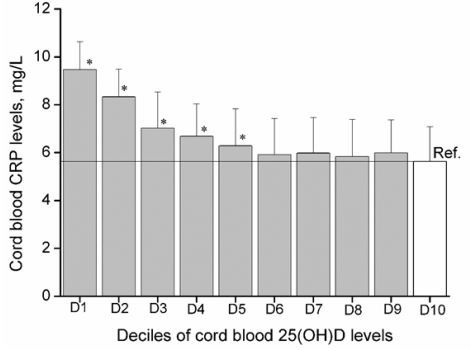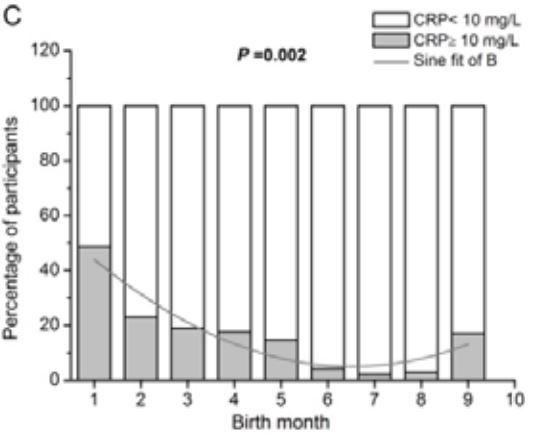Inflammation (CRP) 3X higher in Winter-Spring neonates with low vitamin D
Inverse Correlation between Vitamin D and C-Reactive Protein in Newborns
Nutrients 2015, 7(11), 9218-9228; doi:10.3390/nu7115468 (registering DOI)
Rui-Xue Tao 1,†, Qi-Fan Zhou 2,†, Zhi-Wei Xu 3, Jia-Hu Hao 2, Kun Huang 2, Zhe Mou 4, Xiao-Min Jiang 5, Fang-Biao Tao 2 and Peng Zhu 2,*
1 Department of Gynecology and Obstetrics, Hefei First People’s Hospital, Hefei 230001, China
2 Department of Maternal, Child & Adolescent Health, and Anhui Provincial Key Laboratory of Population Health & Aristogenics, Anhui Medical University, Hefei 230032, China
3 School of Public Health and Social Work, and Institute of Health and Biomedical Innovation, Queensland University of Technology, Brisbane 4059, Australia
4 Shanghai Key Laboratory of Meteorology and Health, Shanghai 200001, China
5 Department of Gynecology and Obstetrics, Hefei Maternal and Child Health Hospital, Hefei 230001, China


Some studies suggested that adequate vitamin D might reduce inflammation in adults. However, little is known about this association in early life. We aimed to determine the relationship between cord blood 25-hydroxyvitamin D (25(OH)D) and C-reactive protein (CRP) in neonates. Cord blood levels of 25(OH)D and CRP were measured in 1491 neonates in Hefei, China. Potential confounders including maternal sociodemographic characteristics, perinatal health status, lifestyle, and birth outcomes were prospectively collected. The average values of cord blood 25(OH)D and CRP were 39.43 nmol/L (SD = 20.35) and 6.71 mg/L (SD = 3.07), respectively.
Stratified by 25(OH)D levels, per 10 nmol/L increase in 25(OH)D, CRP decreased by 1.42 mg/L (95% CI: 0.90, 1.95) among neonates with 25(OH)D <25.0 nmol/L, and decreased by 0.49 mg/L (95% CI: 0.17, 0.80) among neonates with 25(OH)D between 25.0 nmol/L and 49.9 nmol/L, after adjusting for potential confounders. However, no significant association between 25(OH)D and CRP was observed among neonates with 25(OH)D ≥50 nmol/L. Cord blood 25(OH)D and CRP levels showed a significant seasonal trend with lower 25(OH)D and higher CRP during winter-spring than summer-autumn. Stratified by season, a significant linear association of 25(OH)D with CRP was observed in neonates born in winter-spring (adjusted β = −0.11, 95% CI: −0.13, −0.10), but not summer-autumn.
Among neonates born in winter-spring, neonates with 25(OH)D <25 nmol/L had higher risk of CRP ≥10 mg/L (adjusted OR = 3.06 , 95% CI: 2.00, 4.69), compared to neonates with 25(OH)D ≥25 nmol/L. Neonates with vitamin D deficiency had higher risk of exposure to elevated inflammation at birth.
